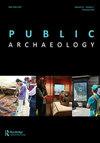Editorial
IF 0.9
4区 历史学
0 ARCHAEOLOGY
引用次数: 0
Abstract
In this issue of Public Archaeology, we devote special coverage to the topic of museums in crisis. In their extended article, Ioannis Poulios and Smaragda Touloupa critically evaluate how archaeology museums in Greece navigated the 2007 Global Financial Crisis and its aftermath of government-imposed austerity measures. The authors survey a range of public and private museums across Greece with a view to understanding their capacity to act in response to the Crisis, assessing the effectiveness of these institution’s actions in both socio-cultural and fiscal terms. Crucially, the authors develop the concept of ‘strategic agility’ — adapted from the world of business — to suggest a means of thinking and acting for museum administrators, to ensure that institutions are able to move swiftly and with a range of approaches to combat prospective threats, whether they be economic, social, or political in scope. Ultimately, their approach is one that encourages more autonomy, control, and entrepreneurialism for museum directors and administrators. The study provides a valuable addition to a body of research examining the effects of the Crisis on Greek cultural life. While some new forms of leisure have resulted from the Crisis — such as graffiti tourism in Athens, or the broader notion of ‘crisis tourism’ (cf. Plantzos, 2018) — the more pressing concerns are the profound structural issues that it has precipitated, which have the potential to radically reconfigure the nature of cultural funding, both in Greece (Tziovas, 2017) but also across Europe. The general (and understandable) outcome of the Crisis has been for museum bodies and commentators to encourage museums to become less dependent on direct government support and increasingly develop their commercial facets (Woodley, et al., 2018). The term ‘resilience’ has entered the museum professional’s lexicon, although perhaps it should give pause for thought that in doing so museums are engaging more directly with the vicissitudes of the market from which they are seeking resilience. When considering the extent to which museums should accede to a greater market orientation, it is vital to understand how such moves influence wider issues such as the privatization of public space, staff and visitor wellbeing, and job/wage precariousness (Palliard, 2017) and how the sector can mitigate such issues. In some ways, the Crisis has acted as a form of shock therapy that has accelerated changes in the museums sector that have been in motion — certainly in the UK — since the 1980s, of reduced government support and the promotion of market orientation. Museums on the Continent have been less susceptible to these changes, but the years since the crisis have provided an aperture to introduce this basic ideology into wider strictures of museum management. While there are undoubtedly benefits to museums pursuing a more commercially responsive management approach, there is a growing sense that austerity is pushing museums to an increasing reliance on public archaeology, Vol. 17 No. 1, February 2018, 1–2编辑
在本期《公共考古》中,我们专门报道了博物馆危机的话题。在他们的扩展文章中,Ioannis Poulios和Smaragda Touloupa批判性地评估了希腊考古博物馆如何应对2007年全球金融危机及其政府实施的紧缩措施。作者调查了希腊各地的一系列公共和私人博物馆,以了解它们应对危机的能力,评估这些机构在社会文化和财政方面的行动的有效性。至关重要的是,作者提出了“战略敏捷性”的概念——改编自商业世界——为博物馆管理人员提供了一种思考和行动的方式,以确保各机构能够迅速采取行动,并采取一系列方法来应对潜在的威胁,无论是经济、社会还是政治威胁。最终,他们的方法是鼓励博物馆馆长和管理人员拥有更多的自主权、控制权和创业精神。这项研究为研究危机对希腊文化生活的影响提供了宝贵的补充。虽然危机带来了一些新的休闲形式,比如雅典的涂鸦旅游,或者更广泛的“危机旅游”概念(参见Plantzos,2018),但更紧迫的问题是它引发的深刻的结构性问题,这些问题有可能从根本上重新配置希腊(Tziovas,2017)和整个欧洲的文化资金性质。危机的总体(也是可以理解的)结果是,博物馆机构和评论家鼓励博物馆减少对政府直接支持的依赖,并更多地发展其商业方面(Woodley等人,2018)。“复原力”一词已经进入博物馆专业人士的词典,尽管也许它应该让人停下来思考,在这样做的过程中,博物馆正在更直接地参与他们寻求复原力的市场的变化。在考虑博物馆应在多大程度上接受更大的市场导向时,至关重要的是要了解这些举措如何影响更广泛的问题,如公共空间私有化、员工和游客福利以及工作/工资不稳定(Palliard,2017),以及该部门如何缓解这些问题。在某些方面,这场危机起到了一种休克疗法的作用,加速了博物馆行业自20世纪80年代以来一直在发生的变化——当然是在英国——政府支持减少和市场导向的促进。欧洲大陆的博物馆不太容易受到这些变化的影响,但危机以来的几年为将这一基本意识形态引入博物馆管理的更广泛限制提供了一个机会。尽管博物馆追求更具商业响应能力的管理方法无疑有好处,但人们越来越感觉到,紧缩政策正在促使博物馆越来越依赖公共考古,第17卷第1期,2018年2月,1-2
本文章由计算机程序翻译,如有差异,请以英文原文为准。
求助全文
约1分钟内获得全文
求助全文

 求助内容:
求助内容: 应助结果提醒方式:
应助结果提醒方式:


